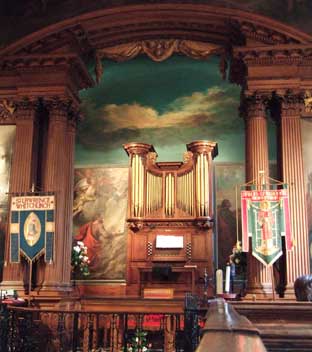St Lawrence, Canons Park
18th February
St Lawrence' church at Canons Park has a special place in the heart of all Handelians if only because it is one of the few places we can be certain that Handel played here really means what it says.
In the ante-chamber to the Mausoleum of the 1st Duke of Chandos, a small case contains the original keyboard to the 1717 Gerard Smith organ which Handel played and it gives us a good indication of the organ which he knew. While the Goetze and Gwynn rebuild of 1995 incorporates original pipework, it goes far further to create an instrument at modern concert pitch and with a far wider range of tone and power. Andrew Benson-Wilson gave the inaugural recital and obviously knows the instrument well. Returning on 18 February for an all-Handel programme, he restrained his registration to give us a better indication not only of the sound Handel would have experienced but also of the more limited range of tone available to him on this and many similar English organs of the time. Handel needed to travel abroad to experience the new enlarged pedal boards and great variety of stops being produced in the Netherlands and Germany at the time.

Andrew Benson-Wilson opened with an arrangement of the overture to Esther which was written for Canons in 1718 and then moved to the Air and variations in D minor. It was not until we came to the Concerto VI in B flat and the following Suite in D minor that we began to feel the bite of Handel's harmony and potential for registrational interest.
The Concerto IV in D minor probably brought us the only familiar melody in its first Allegro, but the Fugue in C minor at last gave us a consummately professional work of genius. The simplicity and beauty of the melodic line, coupled with the creativity of its harmony was immediately impressive in the light of the earlier works.
The concert finished with the Chaccone in G which probably needed an even bigger instrument than St Lawrence could boast but allowed us to hear the strengths of the Goetze and Gwynn rebuild.
A charming piece for musical clock served as a suitable encore to a fine afternoon, attended by a very large and enthusiastic audience.
BH
